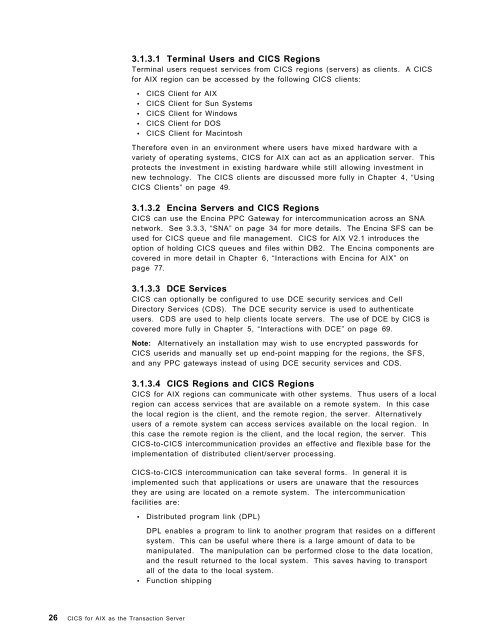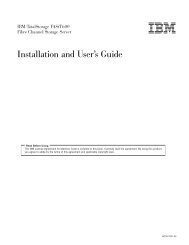Addressing OLTP Solutions with CICS: The Transaction Server ... - Ibm
Addressing OLTP Solutions with CICS: The Transaction Server ... - Ibm
Addressing OLTP Solutions with CICS: The Transaction Server ... - Ibm
Create successful ePaper yourself
Turn your PDF publications into a flip-book with our unique Google optimized e-Paper software.
3.1.3.1 Terminal Users and <strong>CICS</strong> Regions<br />
Terminal users request services from <strong>CICS</strong> regions (servers) as clients. A <strong>CICS</strong><br />
for AIX region can be accessed by the following <strong>CICS</strong> clients:<br />
• <strong>CICS</strong> Client for AIX<br />
26 <strong>CICS</strong> for AIX as the <strong>Transaction</strong> <strong>Server</strong><br />
• <strong>CICS</strong> Client for Sun Systems<br />
• <strong>CICS</strong> Client for Windows<br />
• <strong>CICS</strong> Client for DOS<br />
• <strong>CICS</strong> Client for Macintosh<br />
<strong>The</strong>refore even in an environment where users have mixed hardware <strong>with</strong> a<br />
variety of operating systems, <strong>CICS</strong> for AIX can act as an application server. This<br />
protects the investment in existing hardware while still allowing investment in<br />
new technology. <strong>The</strong> <strong>CICS</strong> clients are discussed more fully in Chapter 4, “Using<br />
<strong>CICS</strong> Clients” on page 49.<br />
3.1.3.2 Encina <strong>Server</strong>s and <strong>CICS</strong> Regions<br />
<strong>CICS</strong> can use the Encina PPC Gateway for intercommunication across an SNA<br />
network. See 3.3.3, “SNA” on page 34 for more details. <strong>The</strong> Encina SFS can be<br />
used for <strong>CICS</strong> queue and file management. <strong>CICS</strong> for AIX V2.1 introduces the<br />
option of holding <strong>CICS</strong> queues and files <strong>with</strong>in DB2. <strong>The</strong> Encina components are<br />
covered in more detail in Chapter 6, “Interactions <strong>with</strong> Encina for AIX” on<br />
page 77.<br />
3.1.3.3 DCE Services<br />
<strong>CICS</strong> can optionally be configured to use DCE security services and Cell<br />
Directory Services (CDS). <strong>The</strong> DCE security service is used to authenticate<br />
users. CDS are used to help clients locate servers. <strong>The</strong> use of DCE by <strong>CICS</strong> is<br />
covered more fully in Chapter 5, “Interactions <strong>with</strong> DCE” on page 69.<br />
Note: Alternatively an installation may wish to use encrypted passwords for<br />
<strong>CICS</strong> userids and manually set up end-point mapping for the regions, the SFS,<br />
and any PPC gateways instead of using DCE security services and CDS.<br />
3.1.3.4 <strong>CICS</strong> Regions and <strong>CICS</strong> Regions<br />
<strong>CICS</strong> for AIX regions can communicate <strong>with</strong> other systems. Thus users of a local<br />
region can access services that are available on a remote system. In this case<br />
the local region is the client, and the remote region, the server. Alternatively<br />
users of a remote system can access services available on the local region. In<br />
this case the remote region is the client, and the local region, the server. This<br />
<strong>CICS</strong>-to-<strong>CICS</strong> intercommunication provides an effective and flexible base for the<br />
implementation of distributed client/server processing.<br />
<strong>CICS</strong>-to-<strong>CICS</strong> intercommunication can take several forms. In general it is<br />
implemented such that applications or users are unaware that the resources<br />
they are using are located on a remote system. <strong>The</strong> intercommunication<br />
facilities are:<br />
• Distributed program link (DPL)<br />
DPL enables a program to link to another program that resides on a different<br />
system. This can be useful where there is a large amount of data to be<br />
manipulated. <strong>The</strong> manipulation can be performed close to the data location,<br />
and the result returned to the local system. This saves having to transport<br />
all of the data to the local system.<br />
• Function shipping
















